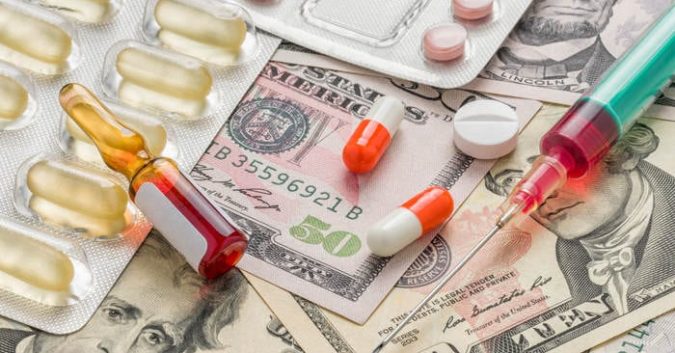It's no secret: Where most decent people see suffering, multi-billion-dollar drug corporations see dollar signs. Dr. Peter B. Bach of Memorial Sloan Kettering Cancer Center in New York City told the New York Times on Tuesday, “Drug companies are quietly making billions forcing little old ladies to buy enough medicine to treat football players, and regulators have completely missed it.” He went on to say, “If we’re ever going to start saving money in health care, this is an obvious place to cut.”
Bach and his fellow researchers at the Memorial Sloan Kettering Cancer Center in New York City conducted a study that estimates that cancer patients and insurers will spend an extra $1.84 Billion on unused cancer medicine in 2016. Patients pay another $1 Billion of excess money in markups charged by doctors and hospitals for that unused medicine. This means that, altogether, Big Pharma is quietly making $3 Billion dollars a year on cancer medicine that patients can't even use. "Some of these drugs are selling for ... 1,000 times the price of gold," Bach said. Much of that value has nothing to do with the drug’s effectiveness, but is artificially created through shady pricing practices.
How Can Corporations Charge Dying People for Medicine They Didn't Use?
Published in BMJ, the study conducted by researchers at Sloan Kettering found that the top 20 cancer drugs, which account for 93 percent of all cancer drug sales, are dosed according to body weight. This means that a 90-pound person and a 250-pound person would require very different amounts of medicine; however, regardless of what doses doctors prescribe, cancer medicine is packaged in predetermined amounts and patients pay for the entire quantity, whether they use it or not.
The study provided an eye-opening example with the drug Keytruda® (pembrolizumab). Originally, the drug was sold in 50 mg vials, but in February 2015 manufacturers only packaged the drug in 100 mg vials. Under the old packaging system, a patient who required 140 mg of medicine a day could have taken three 50mg vials, leaving only 10 mg wasted. Under the new packaging system, that patient is required to open two 100 mg vials, leaving 60mg in waste. Consider that Keytruda® costs roughly $50 per 1mg of medicine. In the example given above, patients pay $500 for unused medicine when there is 10mg leftover. That cost skyrockets to $3000 when there is 60mg leftover. Despite the enormous change in cost, the patient is still using the same amount of medicine.
How Did This Wasteful System Come to Exist?
Bach and his team blame vague and contradictory federal regulations for allowing pharmaceutical companies to price-gouge patients. The Food and Drug Administration (FDA) requires that companies package drugs so that most patients only need one vial for a single dose, while at the same time asking companies to minimize waste. These 2 regulations sit at direct odds with each other and are so loosely enforced that pharmaceutical companies essentially get a pass to take cancer patients for the most money possible.
One solution would be to recycle the unused medicine. But unfortunately that’s not permitted in many cases. The nurses who inject patients with these cancer drugs can't reuse the leftover medicine (except in very special circumstances) because of contamination risks. In his study, Dr. Bach encouraged major public health agencies like the FDA, Center for Disease Control and Prevention (CDC), Centers for Medicare and Medicaid Services (CMMS) to reconcile their different takes on the safety of reusing leftover drugs. If a certified drug disposal system was in place, medical professionals could gather the unused medicine and use it on future patients. It’s also of little use for nurses to inject patients with more than their recommended dose because in many cases overdosing a patient will have no beneficial effect, and in some cases can even be harmful.
Bach's study suggests that some of this enormous waste could be reduced by simply packaging the drugs in a wider variety of vial sizes. This strategy alone would reduce the cost of waste from $1.8 Billion to $400 Million and would, overall, save patients, as well as private and federal health insurers, about $2 Billion a year. Another alternative solution, in Bach's opinion, is to allow manufacturers to keep selecting their own packaging quantities, but to refund the cost of leftover drugs to insurers and the government.
Will U.S. Health Agencies Work On Behalf of Cancer Patients?
At the end of the day, what is perhaps most despicable is that this maneuver by Big Pharma not only puts profits ahead of people, it leaves those suffering from cancer to foot the bill. It’s a shame that pharmaceutical companies can’t be trusted to fairly price life-saving medicine, but the United States is long past the point of expecting its private corporations to act with any kind of moral decency. Instead it falls to the government to demand sensible and humane pricing from the private sector. In the conclusion of his study, Bach emphasized how quality healthcare involves easing the pain of patients financially as well as physically: "Such steps could lead to savings for our healthcare system without sacrificing health outcomes. Opportunities to eradicate waste of this kind are rare." Hopefully federal agencies like the FDA seize this opportunity and fight on behalf of cancer patients nationwide.
